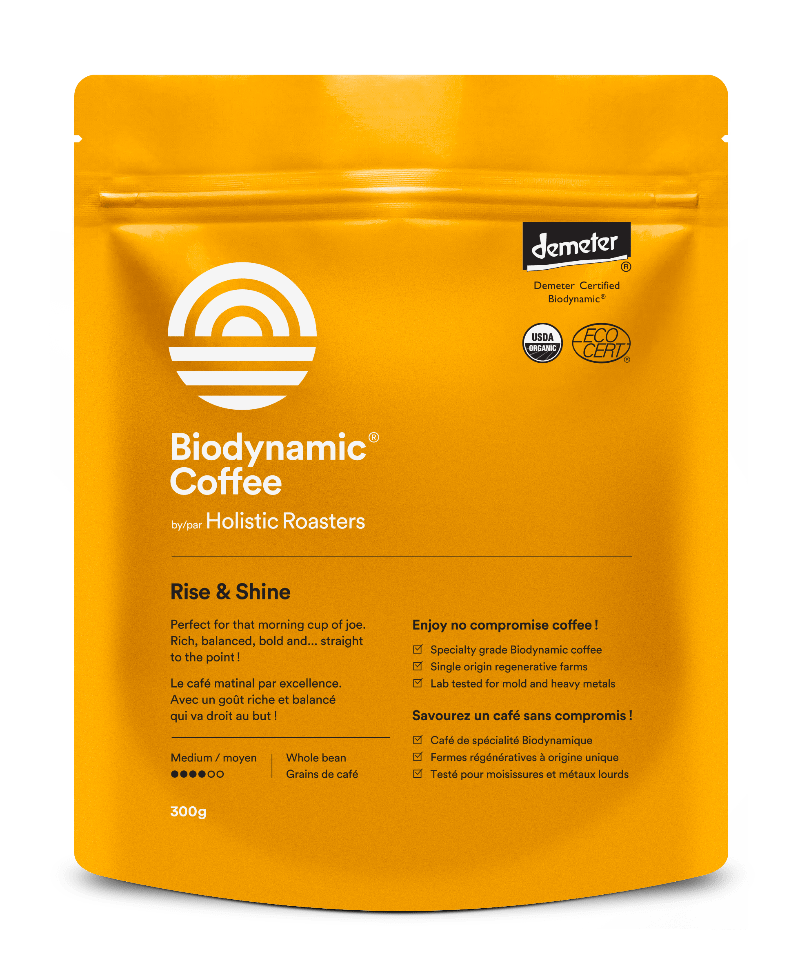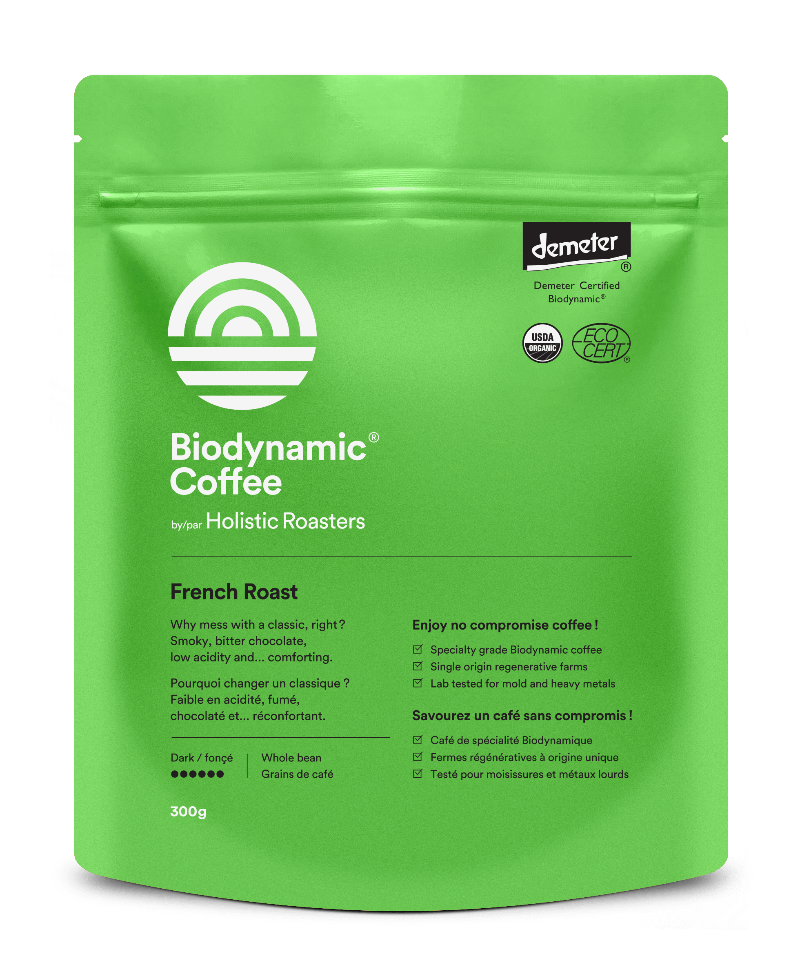Why Biodynamic Coffee is the Cleanest Cup You Can Drink
Understanding Your Coffee's Lab Tests
When you download lab test results for your Biodynamic coffee, you're looking at evidence of our commitment to quality, safety, and transparency. But what exactly do these tests mean? Let's break down the science behind your morning cup and why these tests matter.

The Quick Scoop
When you sip your Biodynamic coffee, you're enjoying a beverage that's been rigorously tested for purity. Our comprehensive lab tests verify that your coffee is free from detectable heavy metals, mycotoxins, and harmful microorganisms. This meticulous testing regimen confirms what Biodynamic farming practices promise: coffee that's clean, pure, and truly exceptional in quality.
The Importance of Testing Coffee
Biodynamic farming represents the highest standard of regenerative agriculture. Unlike conventional coffee, Biodynamic coffee is grown using practices that enhance the ecosystem, promote biodiversity, and prohibit synthetic chemicals. Lab testing serves as verification that our coffee meets these exacting standards and is free from contaminants that can affect both flavor and health.
This comparison illustrates how Biodynamic coffee consistently outperforms conventional coffee across key quality and safety metrics. This is a direct result of regenerative farming practices and comprehensive testing protocols.
The Three Types of Tests We Conduct
1. Heavy Metals Analysis
What we test for: Arsenic, Cadmium, Mercury, and Lead
| Test Type | Result (ppb) | Detection Limit (ppb) | Industry Standard (ppb) | Status |
|---|---|---|---|---|
| Arsenic | <20 | 20 | 100-1000 | Below Detection Limit |
| Cadmium | <8 | 8 | 100-1000 | Below Detection Limit |
| Mercury | <10 | 10 | 20-100 | Below Detection Limit |
| Lead | <17 | 17 | 100-1000 | Below Detection Limit |
How it's done: Using a sophisticated technique called ICP-MS (Inductively Coupled Plasma Mass Spectrometry), labs can detect even minute traces of heavy metals in coffee. The process begins with a micro-wave digestion that breaks down the coffee sample into a solution that can be analyzed by the spectrometer, which identifies elements based on their atomic mass.
Why it matters: Heavy metals can accumulate in soil from industrial pollution, agricultural runoff, or even naturally occurring deposits. While trace amounts exist naturally in many foods, excessive levels can pose health risks. Our tests consistently show that our Biodynamic farming practices maintain levels well below industry standards, and below even the detection limits of advanced lab equipment.
What the results mean: When you see "Below Detection Limit" on our reports, it means the amount (if any) is so small that even sensitive lab equipment can't measure it – a great sign for your coffee's purity.
2. Mycotoxins Analysis
What we test for: Multiple mycotoxin compounds including Aflatoxins (B1, B2, G1, G2), Ochratoxin A, Deoxynivalenol (DON), Fumonisins, and Zearalenone
| Test Type | Result (ppb) | Detection Limit (ppb) | Industry Standard (ppb) | Status |
|---|---|---|---|---|
| Aflatoxin B1 | <1 | 1 | 5-20 | Below Detection Limit |
| Aflatoxin B2 | <1 | 1 | 5-20 | Below Detection Limit |
| Aflatoxin G1 | <1 | 1 | 5-20 | Below Detection Limit |
| Aflatoxin G2 | <1 | 1 | 5-20 | Below Detection Limit |
| Ochratoxin A | <3 | 3 | 5-20 | Below Detection Limit |
| Deoxynivalenol (DON) | <60 | 60 | 750-1000 | Below Detection Limit |
| Fumonisin B1 | <100 | 100 | 2000-4000 | Below Detection Limit |
| Fumonisin B2 | <100 | 100 | 2000-4000 | Below Detection Limit |
| Zearalenone | <30 | 30 | 100-400 | Below Detection Limit |
How it's done: Labs use liquid chromatography coupled with mass spectrometry (LC-MS) to separate and identify these compounds. This advanced analytical method can detect mycotoxins at parts per billion (ppb) levels – imagine finding a single grain of sand in an Olympic-sized swimming pool!
Why it matters: Mycotoxins are natural compounds produced by certain molds that can grow on coffee during cultivation, processing, or storage, particularly in humid conditions. Some mycotoxins are associated with health concerns when consumed regularly at high levels. Good cultivation practices significantly reduce the risk of mycotoxin formation through proper cultivation, careful harvesting, and meticulous processing and storage.
What the results mean: Our tests show that all mycotoxins in our Biodynamic coffee are below detectable limits, demonstrating the effectiveness of our Biodynamic farming and processing methods in preventing mold growth.
3. Microbiological Analysis
What we test for: Escherichia coli (E. coli), Salmonella, and Listeria monocytogenes
| Test Type | Result | Industry Standard | Status |
|---|---|---|---|
| Escherichia coli | <10 CFU/g | <100 CFU/g | Below Detection Limit |
| Salmonella spp. | Not Detected (in 25g) | Absence in 25g | Not Detected |
| Listeria monocytogenes | Not Detected (in 25g) | Absence in 25g | Not Detected |
How it's done: For these tests, samples are cultured in specialized growth media to detect the presence of potentially harmful bacteria. For E. coli, labs use Petrifilm, a ready-made culture medium that allows quick identification and counting of bacterial colonies. For Salmonella and Listeria, an enrichment process is followed by PCR (Polymerase Chain Reaction) to detect even small amounts of bacterial DNA.
Why it matters: Microbiological testing ensures that coffee is free from pathogens that could cause foodborne illness. While coffee roasting typically kills bacteria, testing provides assurance of proper handling throughout the supply chain.
What the results mean: Our Biodynamic coffee shows no detectable levels of harmful microorganisms, confirming the hygienic processing of our coffee from farm to packaging.
Understanding the Units: What is PPB?
Our lab reports list contaminant levels in "parts per billion" (ppb), which can be difficult to conceptualize. To put it in perspective:
If 1 billion seconds is about 32 years, then 1 ppb is just a single second within that timespan.
1 ppb is equivalent to 1 inch in 16,000 miles (nearly two-thirds of the Earth's circumference).
1 ppb is like 1 drop of water in 13,200 gallons (a standard 50' x 25' swimming pool).
How Biodynamic Farming Produces Cleaner Coffee
Biodynamic agriculture goes beyond organic by treating the farm as a self-sustaining organism. This approach leads to coffee that consistently tests clean for several reasons:
Healthy Soil Microbiome
Biodynamic practices create robust soil ecosystems that naturally filter and process potential contaminants.
Absence of Synthetic Chemicals
Since no artificial pesticides or fertilizers are used, there's no risk of their residues appearing in the final product.
Biodiversity
The diverse plant and animal life on Biodynamic farms creates natural resistance to pests and diseases, reducing the need for interventions.
Careful Processing
Biodynamic certification extends to processing methods, ensuring careful handling that prevents contamination and preserves quality.
Holistic Approach
The attention to cosmic and seasonal rhythms in Biodynamic farming creates stronger, more resilient plants that naturally resist fungi and produce beans with optimal chemical compositions.
Why We Test Every Harvest
Coffee is an agricultural product influenced by seasonal variations, changes in climate, and many other factors. By testing every harvest, we ensure consistent quality and safety while gaining insights that help us continually improve our growing and processing methods.
Consistent Testing
We test 100% of our harvests to ensure that every batch of coffee meets our rigorous quality and safety standards.
Quality Improvement
Frequent cupping (professional tasting) helps us refine our methods and continuously improve the quality of our coffee.
Complete Transparency
By sharing our test results with you, we're providing complete transparency about the quality and safety of your coffee.
The Bottom Line: What These Results Mean For Your Cup
When you enjoy your Biodynamic coffee, you're drinking coffee that has been verified to contain:
- No detectable heavy metals
- No detectable mycotoxins
- No harmful microorganisms
This purity translates directly to flavor. Without contaminants masking the coffee's true character, you can fully experience the unique terroir and carefully developed flavor profile that makes our Biodynamic coffee special.
Beyond taste, these test results represent our commitment to your health and to agricultural practices that regenerate rather than deplete the environment. With every cup, you're supporting a system of farming that benefits the soil, the farmers, the ecosystem, and ultimately, your wellbeing.
So the next time you download our lab results, know that those "Below Detection Limit" notations represent thousands of careful decisions made by our farmers, processors, and quality control team – all working together to bring you the purest possible cup of Biodynamic coffee.
Experience the Difference of Truly Clean Coffee
At Holistic Roasters, we don't just focus on creating exceptional coffee—we're dedicated to ensuring that every cup you enjoy is as safe as it is delicious. By implementing stringent testing practices, we verify the purity of our Biodynamic coffee, delivering a product that meets the highest standards of quality and safety.
When you choose Holistic Roasters, you're choosing mold-free, toxin-free coffee.
Original reports: Eurofins-EnvironeX Certificate M2257367 and M2256529, Actlabs Mycotoxin Analysis CA23-D-FEB9-005




